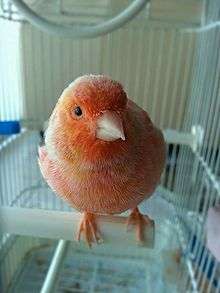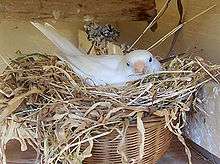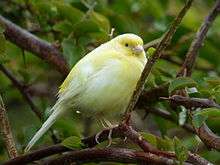Domestic canary
| Canary | |
|---|---|
 | |
| A red factor canary | |
Domesticated | |
| Scientific classification | |
| Kingdom: | Animalia |
| Phylum: | Chordata |
| Class: | Aves |
| Order: | Passeriformes |
| Family: | Fringillidae |
| Subfamily: | Carduelinae |
| Genus: | Serinus |
| Species: | S. canaria |
| Subspecies: | S. c. domestica |
| Trinomial name | |
| Serinus canaria domestica | |
| Synonyms | |
|
Serinus canarius domesticus[3] Linnaeus 1758, I. Geoffroy Saint-Hilaire, 1861[4] | |
The domestic canary, often simply known as the canary (Serinus canaria forma domestica[5]), is a domesticated form of the wild canary, a small songbird in the finch family originating from the Macaronesian Islands (The Azores, Madeira and the Canary Islands).
Canaries were first bred in captivity in the 17th century. They were brought over by Spanish sailors to Europe. This bird became expensive and fashionable to breed in courts of Spanish and English kings.[6][7] Monks started breeding them and only sold the males (which sing). This kept the birds in short supply and drove the price up. Eventually, Italians obtained hens and were able to breed the birds. This made them very popular, resulted in many breeds arising, and the birds being bred all over Europe.
The same occurred in England. First the birds were only owned by the rich, but eventually the local citizens started to breed them and, again, they became very popular. Many breeds arose through selective breeding, and they are still very popular today for their voices.
From the eighteenth up to twentieth centuries, canaries and finches were used in the UK, Canada and USA in the coal mining industry, to detect carbon monoxide. In the UK, this practice ceased in 1986.[8]
Typically, the domestic canary is kept as a popular cage and aviary bird. Given proper housing and care, a canary's lifespan ranges from 10 to 15 years.[9]
Etymology
The birds are named after Spain's Canary Islands, which derive their name from the Latin Insula Canaria (after one of the larger islands, Gran Canaria), meaning "island of dogs", due to its "vast multitudes of dogs of very large size".[10][11]


Varieties
Canaries are generally divided into three main groups:
- Colour-bred canaries (bred for their many colour mutations – ino, eumo, satinette, bronze, ivory, onyx, mosaic, brown and red factor etc.)
- Type canaries (bred for their shape and conformation – Australian plainhead, Berner, Border, Fife, Gibber Italicus, Gloster, Lancashire, Raza Española, Yorkshire, etc.)
- Song canaries (bred for their unique and specific song patterns – Spanish Timbrado, German Roller (also known as Harz Roller), Waterslager (also known as "Malinois"), American Singer, Russian Singer, Persian Singer).
While wild canaries are a yellowish-green colour, domestic canaries have been selectively bred for a wide variety of colours, such as yellow, orange, brown, black, white, and red. (The colour red was introduced to the domesticated canary through hybridisation with the red siskin, a type of South American finch.[12])
Competitions
Canaries are judged in competitions following the annual molt in the summer.[13] This means that in the Northern Hemisphere the show season generally begins in October or November and runs through December or January. Birds can only be shown by the persons who raised them. A show bird must have a unique band on its leg indicating the year of birth, the band number, and the club to which the breeder belongs.
There are many canary shows all over the world. The world show (C.O.M. - Confederation Ornithologique Mondiale) is held in Europe each year and attracts thousands of breeders. As many as 20,000 birds are brought together for this competition.
Miner's canary
Canaries were once regularly used in coal mining as an early warning system.[14] Toxic gases such as carbon monoxide or methane[15] in the mine would kill the bird before affecting the miners. Signs of distress from the bird indicated to the miners that conditions were unsafe. The use of miners' canaries in British mines was phased out in 1986.[16]
The phrase "canary in a coal mine" is frequently used to refer to a person or thing which serves as an early warning of a coming crisis. By analogy, the term "climate canary" is used to refer to a species that is affected by an environmental danger prior to other species, thus serving as an early warning system for the other species with regard to the danger.[17] (See indicator species.)
Use in research
Canaries have been extensively used in research to study neurogenesis, or the birth of new neurons in the adult brain, and also for basic research in order to understand how songbirds encode and produce song. Thus, canaries have served as model species for discovering how the vertebrate brain learns, consolidates memories, and recalls coordinated motor movements.
Fernando Nottebohm, a professor at the Rockefeller University in New York City, detailed the brain structures and pathways that are involved in the production of bird song.[18][19]
In culture
In organized crime, the canary symbolizes an informant who "sings to the police."[20]
Canaries have been depicted in cartoons from the mid-20th century as being harassed by domestic cats; the most famous cartoon canary is Warner Bros.' "Tweety".
Norwich City, an English football team, is nicknamed "The Canaries" due to the city once being a famous centre for breeding and export of the birds. The club adopted the colours of yellow and green in homage. Jacob Mackley, of Norwich, won many prizes with birds of the local variety and shipped about 10,000 from Norwich to New York every year. In the early 1900s, he opened his aviaries to the public for three days and 10,000 people turned up. A number of other sports teams worldwide use variations of the name "Canaries", such as Frosinone (Italy), Koper (Slovenia), FC Novi Sad (Serbia), Fenerbahçe (Turkey), Kedah FA (Malaysia), the Brazil national football team and the Brazil women's national football team.
See also
References
- ↑ Index to Organism Names (ION) Archived February 21, 2014, at the Wayback Machine.
- ↑ Encyclopedia of life
- ↑ ION, Index to Organism Names
- ↑ The Taxonomicon
- ↑ Hawley, DM; Grodio, J; Frasca, S; Kirkpatrick, L; Ley, DH. "Experimental infection of domestic canaries (Serinus canaria domestica) with Mycoplasma gallisepticum: a new model system for a wildlife disease". Avian Pathol. 40: 321–7. doi:10.1080/03079457.2011.571660. PMID 21711192.
- ↑ Arnaiz-Villena, A.; Ruiz-del-Valle V.; Areces C. (May 2012). "El Origen de los Canarios" (PDF). Ornitología Práctica. 53: 3–11.
- ↑ Arnaiz-Villena, A; Gómez-Prieto P; Ruiz-de-Valle V (2009). "Phylogeography of finches and sparrows". Nova Science Publishers. ISBN 978-1-60741-844--3.
- ↑ Eschener, Kat (30 December 2016). "The Story of the Real Canary in the Coal Mine". Smithsonian. Retrieved 11 June 2018.
- ↑ Animal-World. "Canary Care". Animal World. Retrieved 2016-02-27.
- ↑ John Hudson Tiner (12 January 2009). Exploring the World of Biology: From Mushrooms to Complex Life Forms. New Leaf Publishing Group. p. 27. ISBN 978-0-89051-552-5. Retrieved 25 July 2012.
- ↑ Pliny the Elder. "Natural History". Retrieved July 25, 2012.
- ↑ Birkhead, Tim (2003). A Brand-New Bird: How Two Amateur Geneticists Create the First Genetically Engineered Animal. NY, NY: Basic Books. ISBN 978-0-465-00665-6.
- ↑ Hogan, Linda S. (1999). The Complete Canary Handbook: A Collection of Canary Tales. self-published. ASIN B0006RK73W.
- ↑ Page, Walter Hines; Page, Arthur Wilson (August 1914). "Man And His Machines: Resuscitation Cage For Mine Canaries". The World's Work: A History of Our Time. XXVIII (May to October 1914): 474. Retrieved 2016-09-19.
- ↑ Biggins, Peter; Kusterbeck, Anne; Hilt, John (2001). Bio-inspired Materials and Sensing Systems. p. 6. ISBN 1849731217. Retrieved October 25, 2016.
- ↑ "1986: Coal mine canaries made redundant". BBC News. 1986-12-30. Retrieved 2010-05-01.
- ↑ "'Plutoed' voted US word of year". BBC News. 2007-01-08. Retrieved 2010-05-01.
- ↑ "Fernando Nottebohm, Ph.D." The Rockefeller University. Retrieved August 11, 2012.
- ↑ "Neurogenesis in Birds". Neurogenesis. Retrieved August 11, 2012.
- ↑ Fitzgerald, Dennis (2014). Informants, Cooperating Witnesses, and Undercover Investigations: A Practical Guide to Law, Policy, and Procedure, Second Edition.
Further reading
- McDonald, Robirda, Brats in Feathers, Keeping Canaries ISBN 0-9730434-4-X
- Miley-Russell, Marie, The Practical Canary Handbook, A Guide to Breeding and Keeping Canaries. ISBN 1-59113-851-5. Especially useful to American Singer canary owners.
- Linda Hogan, Canary Tales
- GB Walker, Colour, Type, and Song Canaries
- David Alderton, Birds Care, You and your pet bird
- Author unknown, The Canary Handbook, Canaries, Barrons
- Tim Hawcroft, Health Care for Birds
- James Blake, Fife Canaries
External links
| Wikimedia Commons has media related to the domestic canary. |
Domestic canary at Curlie (based on DMOZ)